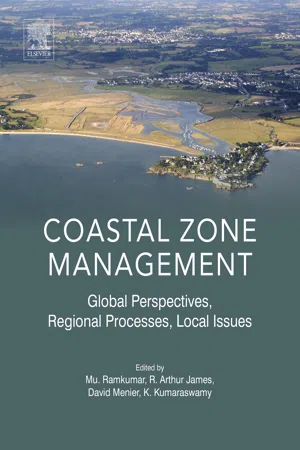
Coastal Zone Management
Global Perspectives, Regional Processes, Local Issues
- 568 pages
- English
- ePUB (mobile friendly)
- Available on iOS & Android
Coastal Zone Management
Global Perspectives, Regional Processes, Local Issues
About this book
Coastal Zone Management: Global Perspectives, Regional Processes, Local Issues brings together a vast range of interdisciplinary data on coastal zones in a concise, yet exhaustive format that will be useful to students, researchers, and teachers. The book contains several focused sections, all of which include individual chapters written by subject experts with considerable experience in their fields of research. Each chapter presents the latest research and status of its focus, with a concluding endnote on future trends. Topics covered in the book include the sea level and climate changes, evolution of coastlines, land-use dynamics and coastal hazards mitigation and management.The global coast has faced the force of both climate hange and natural disasters, which continue to result in the loss of human life and degradation of quality of the coastal environment. Coastal Zone Management: Global Perspectives, Regional Processes, Local Issues provides the latest developments and key strategies to tackle this in a single comprehensive volume. It is an essential reference for scientists and researchers well-read on coastal zones, as well as those new to the subject.- Presents a unique compilation of contributed chapters, including a focus on methodology, case studies, stategy, and policy, acting as a one-source reference for students, teachers, researchers and administrators.- Discusses challenges at local levels in order to help interpret regional processes that have global ramifications.- Provides a database for scientists working on research topics related to coastal zone management.
Frequently asked questions
- Essential is ideal for learners and professionals who enjoy exploring a wide range of subjects. Access the Essential Library with 800,000+ trusted titles and best-sellers across business, personal growth, and the humanities. Includes unlimited reading time and Standard Read Aloud voice.
- Complete: Perfect for advanced learners and researchers needing full, unrestricted access. Unlock 1.4M+ books across hundreds of subjects, including academic and specialized titles. The Complete Plan also includes advanced features like Premium Read Aloud and Research Assistant.
Please note we cannot support devices running on iOS 13 and Android 7 or earlier. Learn more about using the app.
Information
Coastal Zone Management During Changing Climate and Rising Sea Level: Transcendence of Institutional, Geographic, and Subject Field Barriers Is the Key
† Géosciences Océan Laboratory UMR CNRS 6538, University of South Brittany, Vannes Cedex, France
‡ Department of Geography, Bharathidasan University, Tiruchirappalli, India
Abstract
Keywords
Acknowledgments
1 Introduction
2 Transcendence of Local Issues to a Global Scale Through Regional Processes
2.1 Spatial-Temporal Scale of Cause-Effect
Table of contents
- Cover image
- Title page
- Table of Contents
- Copyright
- Contributors
- Preface
- Acknowledgments
- Chapter 1: Coastal Zone Management During Changing Climate and Rising Sea Level: Transcendence of Institutional, Geographic, and Subject Field Barriers Is the Key
- Part 1: Sealevel Cycles and Oceanography
- Part 2: Shoreline and Coastal Changes
- Part 3: Coastal Hydrogeology
- Part 4: Coastal Sediment Geochemistry
- Part 5: Coastal Zone Management Concepts and Applications
- Index